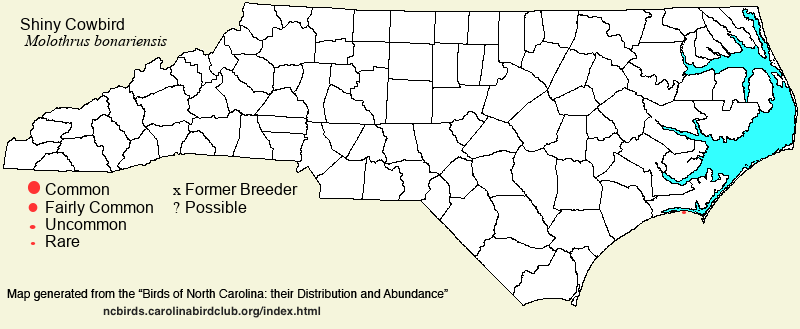 |  |
|
Shiny Cowbird - Molothrus bonariensis ICTERIDAE Members: | Search Common: Search Scientific: |
|
|
|||||||
| General Comments | The Shiny Cowbird, common and widespread in the Neotropics, spread northward through the West Indies and to southern Florida, several decades ago. Thankfully for many native species of warblers and other small songbirds -- the cowbird is an obligate brood parasite -- this northward spread has slowed considerably in recent years. North Carolina got its first record in 1989, and the number of records (practically all in the Coastal Plain in the warmer months) greatly increased for the next 10-12 years. Since about 2002, the records have slowed to perhaps one per year, down from about two per year, despite the increase in birders. This decline is likely due to aggressive eradication of Shiny Cowbirds in recent years by wildlife officials in FL, and possibly in GA and SC. Shiny Cowbirds may have laid eggs in North Carolina in 2017 -- not a good situation, as the species could impact the State-listed Painted Bunting if breeding cowbirds become established along the coast. Birds have appeared in many different situations, such as at bird feeders in open residential areas and in small flocks of Brown-headed Cowbirds feeding on lawns, usually within a few miles of the coast, often in towns and cities near the coast. Most records have been of males, presumably as that sex is more easily differentiated from Brown-headed Cowbirds than is the female, which also could be confused with a female Brewer's Blackbird. | ||||||
| Breeding Status | Accidental Breeder | ||||||
| NC BRC List | Definitive | ||||||
| State Status | |||||||
| U.S. Status | |||||||
| State Rank | SZ | ||||||
| Global Rank | G5 | ||||||
| Coastal Plain | Scarce visitor, and apparent breeder at one site in 2017. Essentially near the coast in the warmer seasons; about 28 records. The species was annual from 1989 through 2000, but has been less than annual since then. Very rare (since 2000) along the southern half of the coast and slightly farther inland; casual to very rare farther north near the coast, and farther inland. These inland records are from Aurora (Beaufort), which was the state's first, on 16 Nov 1989 [Chat 54:82-85 link]; New Bern, 9-29 Oct 1990; Goose Creek SP (Beaufort), 19-25 Jan 2005; and Fayetteville on 30 Oct 1991 (4 birds) and 8 May 1999. Essentially only from early May to mid-Nov, although there are two reports in Jan-Feb. In summer 2017, an adult male was repeatedly seen at feeders in Fort Macon SP (Carteret) and was joined by a female starting on 18 Jun; a juvenile was seen with the female on 5 Aug [Chat 81:111 link]. This series of observations strongly suggest breeding by this pair, which is the first such evidence of nesting in the state. Almost certainly the same male returned to the Fort Macon feeders in 2018, starting on 20 Apr. These same feeders at Fort Macon hosted a male on 31 May 2024. Peak counts: 4, see above. | ||||||
| Piedmont | Accidental, though none yet accepted by the NC BRC. There are two reports: one from Winston-Salem on 9 Nov 1996 [Chat 61:291-92 link]; and one from Hillsborough (Orange) on 14 Jun 2008. The first report was "unresolved" (neither accepted nor rejected) by the NC BRC [Chat 62:182 link]. The second report has not been reviewed by the Committee. | ||||||
| Mountains | No records. | ||||||
| Finding Tips |
Your best bet is to check any cowbirds you see close to the southern coast in the warmer months, particularly when seen feeding on the ground, as species identification is much easier than when blackbirds are in trees. Of course, practically all will be Brown-headeds! The feeders at Fort Macon SP have had the most records in recent years. * | ||||||
| Attribution | LeGrand[2024-08-06], LeGrand[2023-04-02], LeGrand[2018-11-09] | ||||||
| NC Map Map depicts all counties with a report (transient or resident) for the species. | Click on county for list of all known species. |
| NC Breeding Season Map Map depicts assumed breeding season abundance for the species. |  |